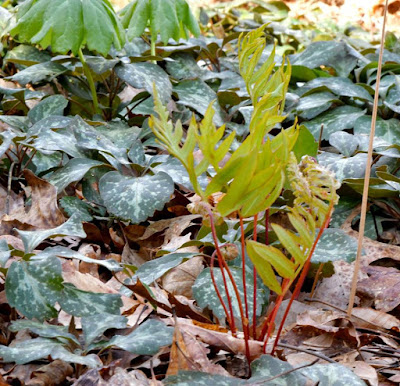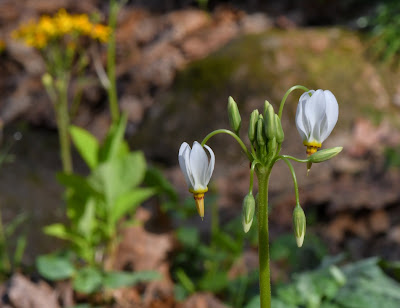Today's Ramble was led by Linda Chafin.
Here's the link
to Don's Facebook album for today's Ramble. (All the photos in this post are
compliments of Don, unless otherwise credited.)
Today's post was written by Linda Chafin.
Today’s Focus:
Dunson Garden and Silverbells on the White Trail Spur
27 Ramblers met today.
Today's reading:
Eugenia read The Cleverness of Seeds by Pat
Brisson
Announcements: Emily announced a herp walk at SCNC next
Wednesday at 9:00 a.m.
Emily also
announced birthdays for three of the Ramblers and said a very pretty chocolate
cake would be served at the post-Ramble social hour.
Today's
Route: We headed straight to the new Children's
Garden for a bit before taking the mulched path down to the Dunson Garden. We omitted the upper sections and made our
way down to the lower Dunson Garden before heading out into the ROW. We then returned via the White Trail Spur
back to the Visitor Center and the Cafe Botanica for our social hour.
LIST OF
OBSERVATIONS:
Alice H. Richards Children's Garden:
Fothergilla (also called Dwarf Witch-alder) was planted at
the entrance of the Children’s Garden and is coming into flower. This is likely
the cultivar known as ‘Mt. Airy,’ discovered by Michael Dirr before he came to
UGA and was working at the Mt. Airy Arboretum in Cincinnati. There are two
species of Fothergilla native to
Georgia and southeast, the low-growing Coastal Witch-alder and the Large
Witch-alder. It’s believed that a cross between these two produced ‘Mt. Airy,’
which is halfway between the two in height. The genus Fothergilla was named in honor of Dr. John Fothergill, a London
physician-botanist during the 1700s.
 | ||
| Fothergilla 'Mt. Airy' | ' |
Close inspection of the Fothergilla flower clusters
reveals two interesting things: they smell great, like honey, and the individual
flowers have no petals. The showy, white structures are stamens, each tipped
with a yellow pollen-producing anther, surrounding a single pistil. Both scent
and color attract bees.
 | |
| Pinxter Azalea |
Mulched Path to
Dunson Garden:
 |
| Flowering sedge; Staminate flower at end, pistilate flowers below. |
Sedges in the genus
Carex are flowering now. This particular species bears a small,
bristly spike of pale yellow, pollen-producing flowers atop an erect
stem–the bristles are stamens. Below, the female flowers are just
developing–their white style branches are protruding
from between the uppermost leaves. The female and male flowers will
mature at different times to prevent self-pollination. If
cross-pollination does occur and fruits develop, we’ll be able to
identify these plants to species. Because sedges don’t usually attract
much attention, most lack common names. Until this one produces fruits,
we’ll just call it a Carex.
 | |
| Hybrid trillium; possibly a cross between Sweet Betsy and Lance-leaf Trillium. |
Among the many hybrid trillium plants that occur in the
Dunson garden, there are some that appear to be hybrids between Sweet Betsy and
Lance-leaf Trillium. The broad leaves are mottled like Sweet Betsy’s and lack
the central silver stripe of the Chattahoochee Trillium. The narrow, clawed,
upright petals that allow you to look through the flowers from the side suggest
Lance-leaf Trillium parentage. Or maybe Spotted Trillium, which also has clawed
petals? It’s anybody’s guess in the Dunson Garden, where trilliums from all
over the state have been brought together in combinations that don’t occur in
nature. (“Clawed” petals are narrow at the base and widen abruptly above the
middle.)
 | |
| Chattahoochee Trillium, with the bright silvery green stripe down the middle of each leaf. |
Several Ramblers observed a Red-Headed Woodpecker getting
a little too close to the Red-Shouldered Hawks nest.
 | |
| Georgia Trillium |
 | |
| Goldenseal flower |
 | |
| May Apples |
 |
| Edna's Trillium (AKA Persistent Trillium) |
ROW and adjacent
areas:
 | |
| Spider egg sac on Highbush Blueberry |
Blueberries are pollinated only by native bees (not
honeybees) that specialize in “buzz pollination” or sonication. These bees
grasp the stamens and vibrate their thoracic muscles, which shakes the pollen
out of a tiny pore at the tip of the specialized anther (“poricidal anther”).
The buzzing sound of sonication is higher pitched than the buzz made by the
bee’s wings. Watch and listen
to this 30-second video and you can hear the difference in the “buzzes” as the
bee visits some blueberry flowers.
Field Pansy is abundant in the right-of-way. We
checked for the characteristic wintergreen smell of the root, but it was very
faint.
 |
| Blue Toadflax in the right-of way. |
 | |
| Corn-salad |
 | |
| Black Cherry bark; the horizontal slits are lenticels. |
White Trail Spur (from ROW to Children's Garden):
 |
| Witch's brooms in Hophornbeam |
 |
| A few Silverbell flowers remain on the small trees next to the right-of-way. |
SUMMARY OF OBSERVED SPECIES
Fothergilla
|
Fothergilla ‘Mt. Airy’.
|
Pinxter Azalea
|
Rhododendron periclymenoides
|
Sedge
|
Carex sp.
|
Hybrid Trillium,
Sweet Betsy and Lanceleaf Trillium |
Trillium cuneatum x. lancifolium
|
Cranefly Orchid
|
Tipularia discolor
|
Golden Ragwort
|
Packera aurea
|
Decumbent Trillium
|
Trillium decumbens
|
Christmas Fern
|
Polystichum acrostichoides
|
Rattlesnake Fern
|
Botrypus virginianus
|
Black Cohosh
|
Actaea racemosa (=
Cimicifuga racemosa)
|
Red-headed Woodpecker
|
Melanerpes erythrocephalus
|
Red-shouldered Hawk
|
Buteo lineatus
|
Georgia Trillium
|
Trillium georgianum
|
Perfoliate Bellwort
|
Uvularia perfoliata
|
Sanicle, Black Snake-root
|
Sanicula sp.
|
Sensitive Fern
|
Onoclea sensibilis
|
Allegheny Spurge
|
Pachysandra procumbens
|
Goldenseal
|
Hydrastis canadensis
|
Devil's Walking Stick
|
Aralia spinosa
|
Virginia Bluebells
|
Mertensia virginica
|
Shooting Stars
|
Primula meadia (=
Dodecatheon meadia)
|
Celandine Wood Poppy
|
Stylophorum diphyllum
|
Woodland Phlox
|
Phlox divaricata
|
Mayapple
|
Podophyllum peltatum
|
Edna’s [Persistent] Trillium
|
Trillium persistens
|
Yellow Three-parted Violet
|
Viola tripartita
|
Highbush Blueberry
|
Vaccinium corymbosum
|
Blue Toadflax
|
Nuttallanthus canadensis
(syn. Linaria canadensis) |
Field Pansy
|
Viola bicolor
|
Purple Deadnettle
|
Lamium purpureum
|
Ground Ivy
|
Glechoma hederacea
|
European Corn-salad
|
Valerianella radiata
|
Butterweed
|
Packera glabella
|
Black Cherry
|
Prunus serotina
|
Hophornbeam
|
Ostrya virginiana
|
Silverbells
|
Halesia tetraptera
|












